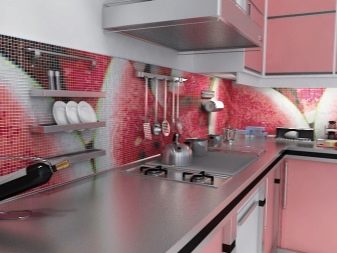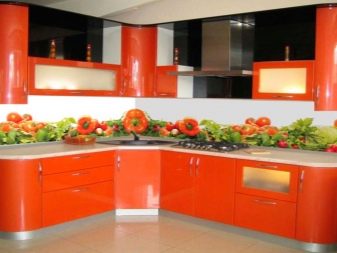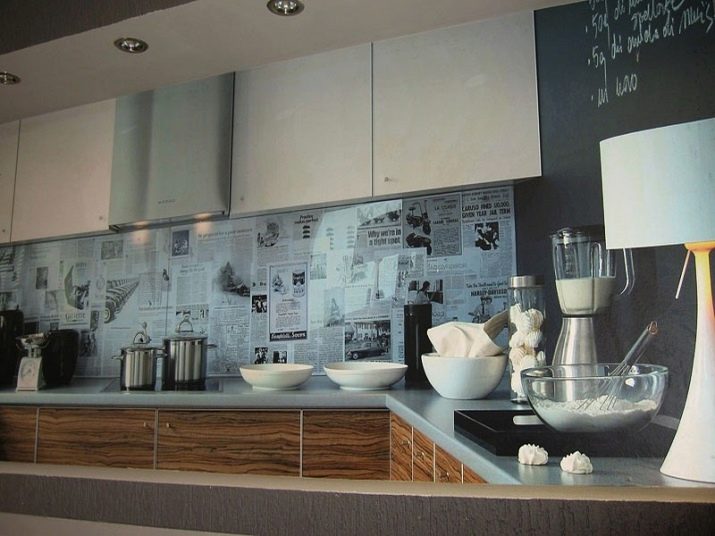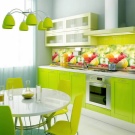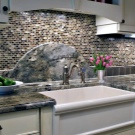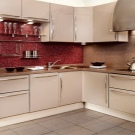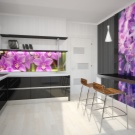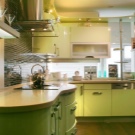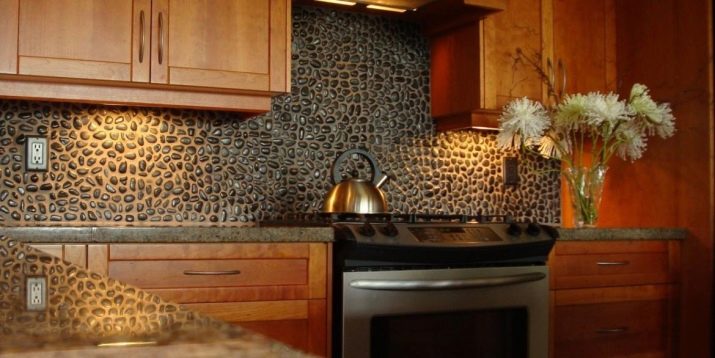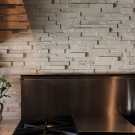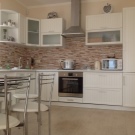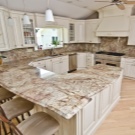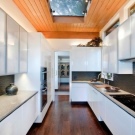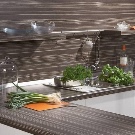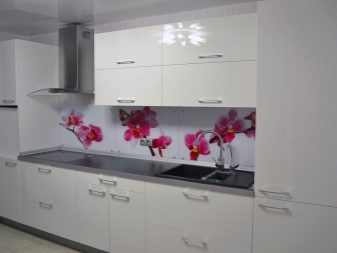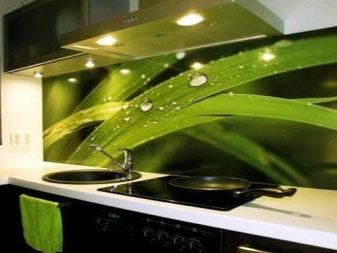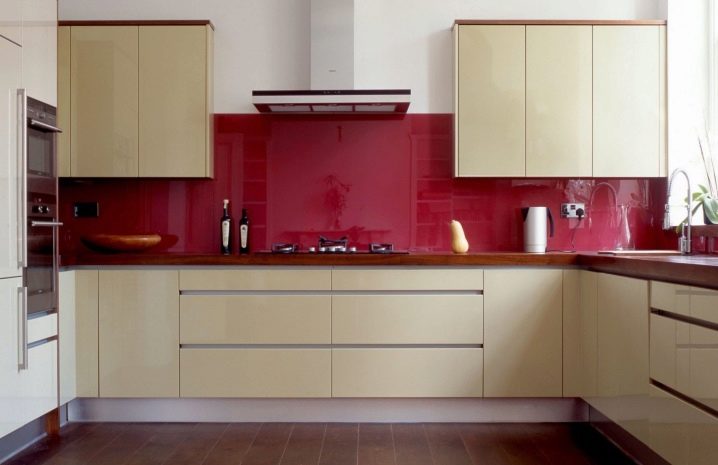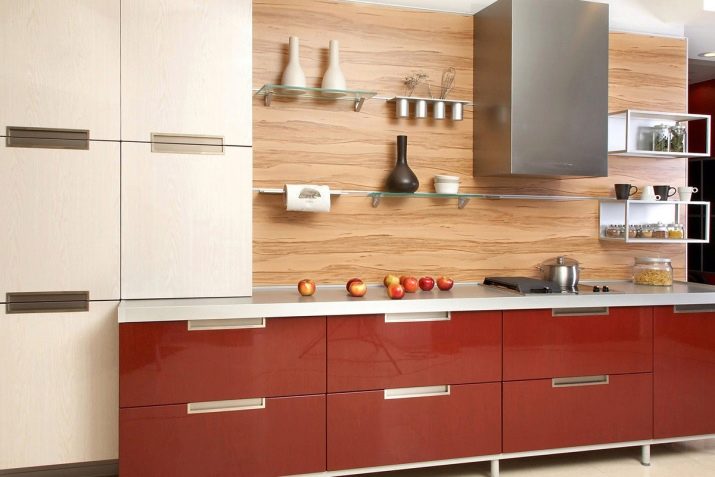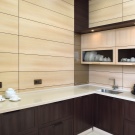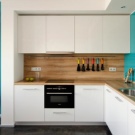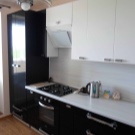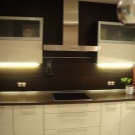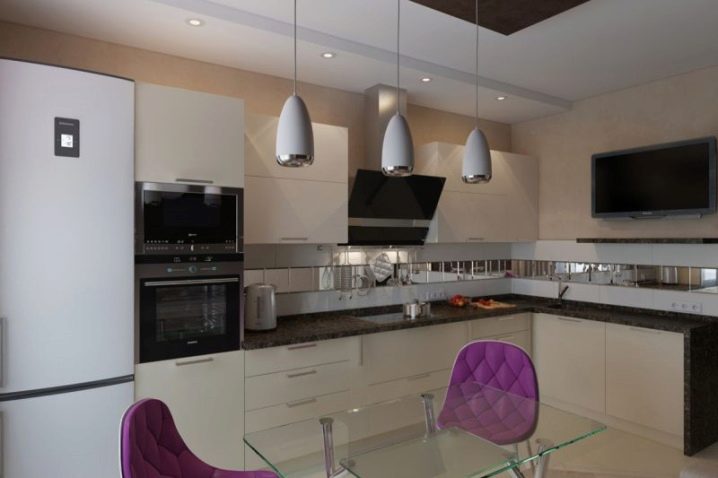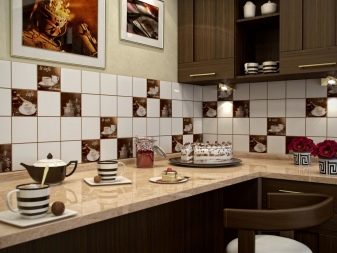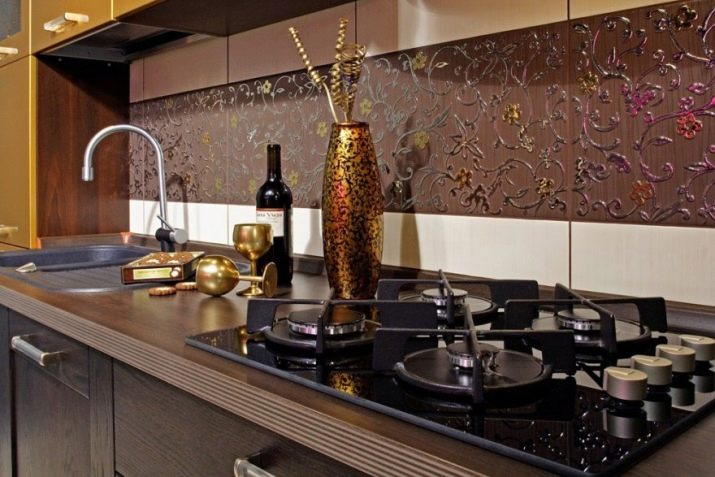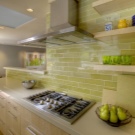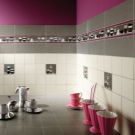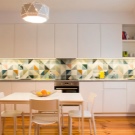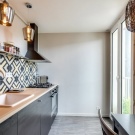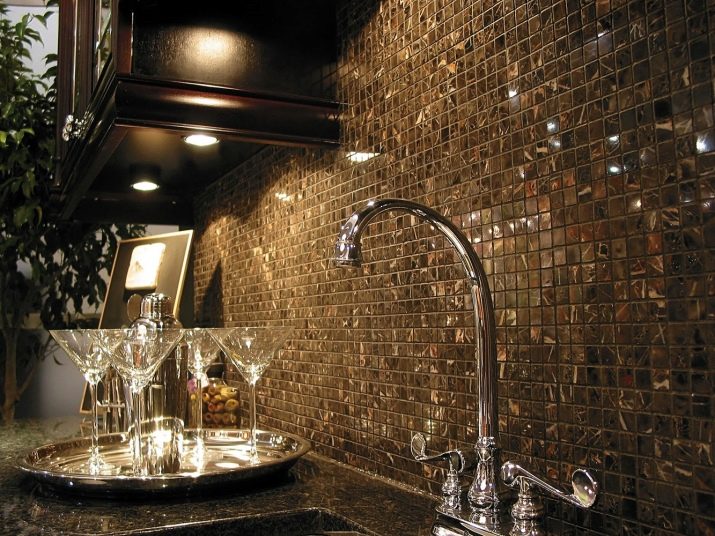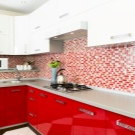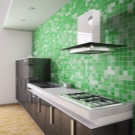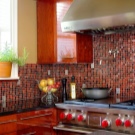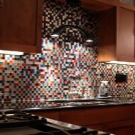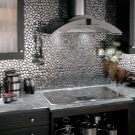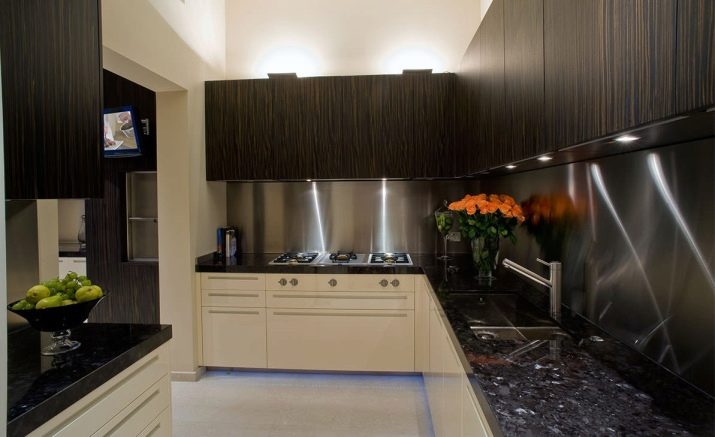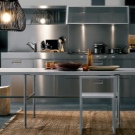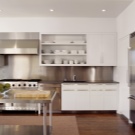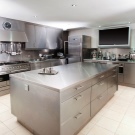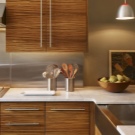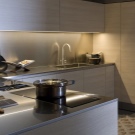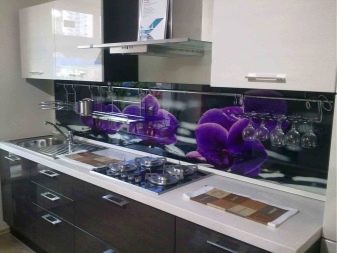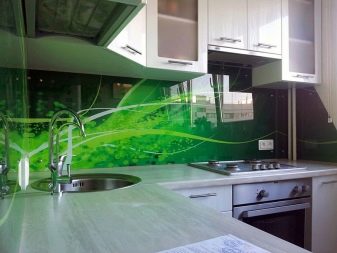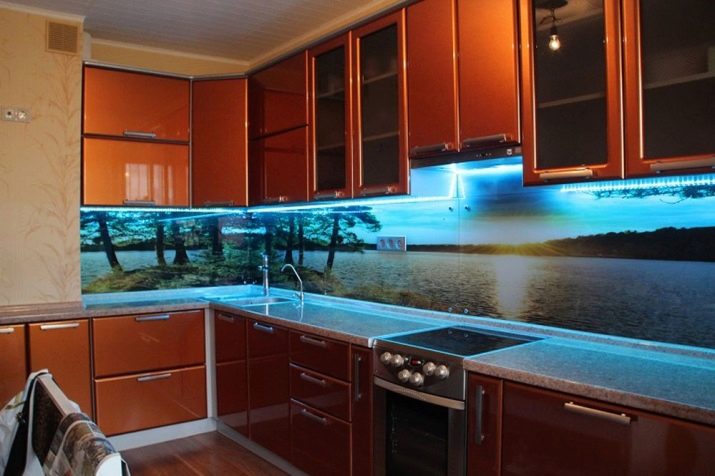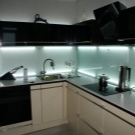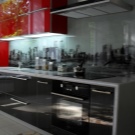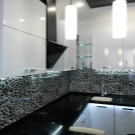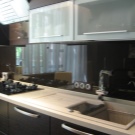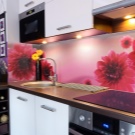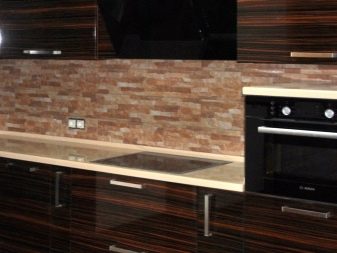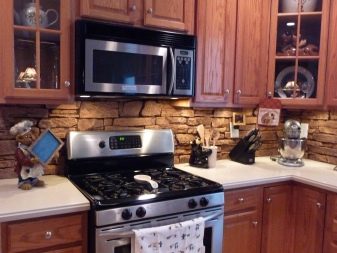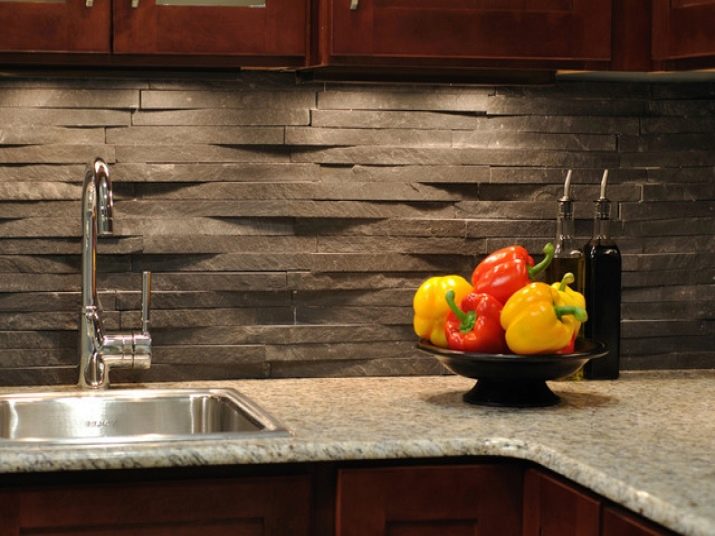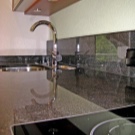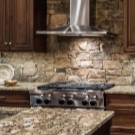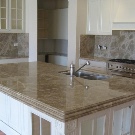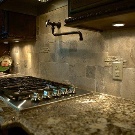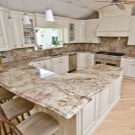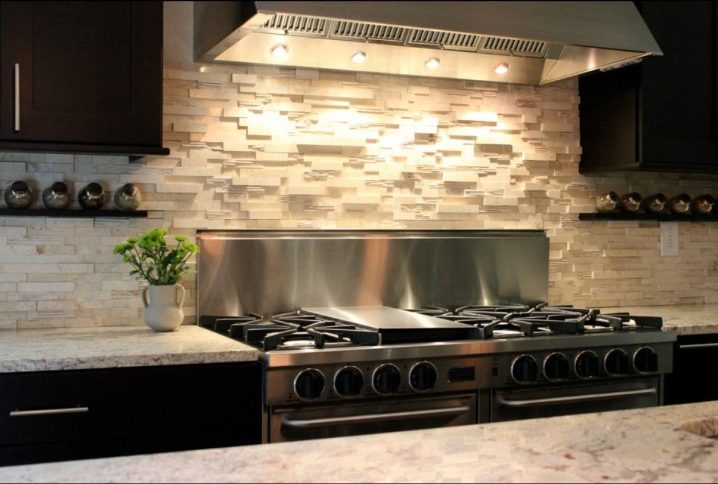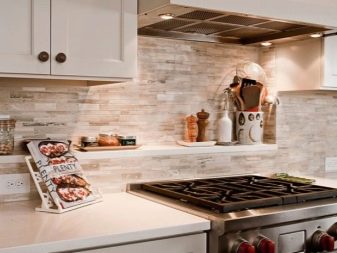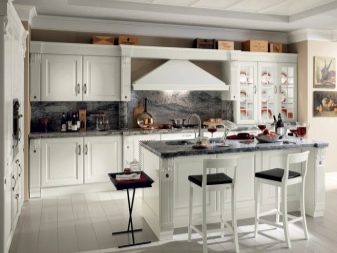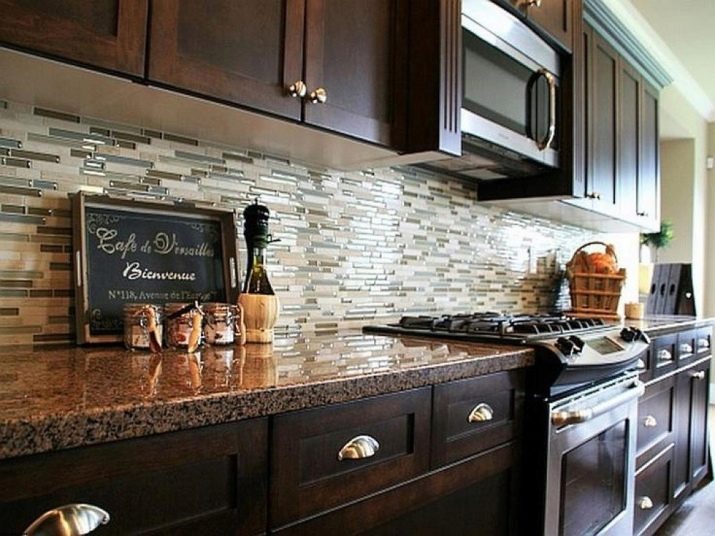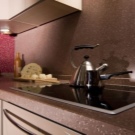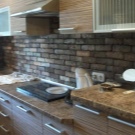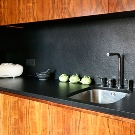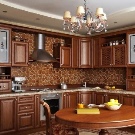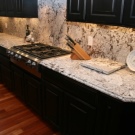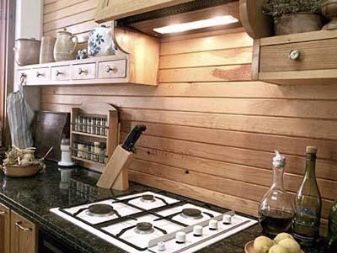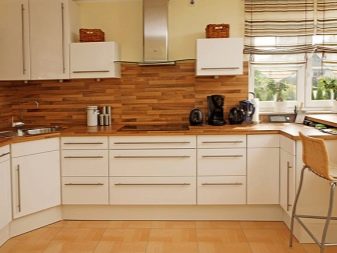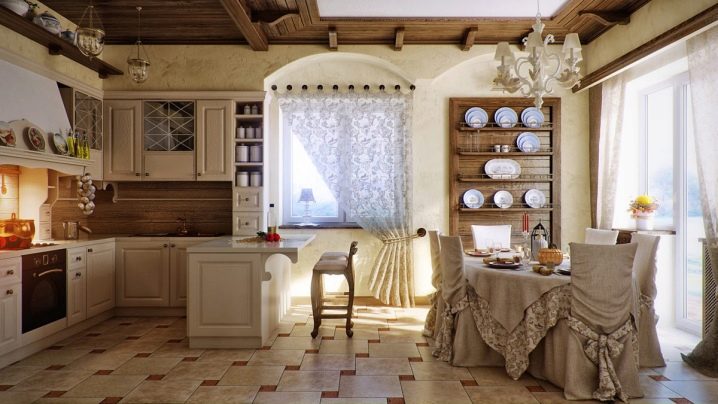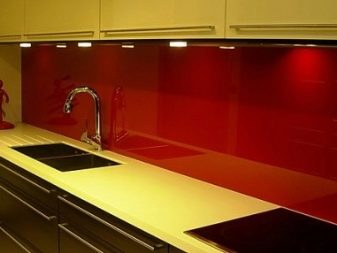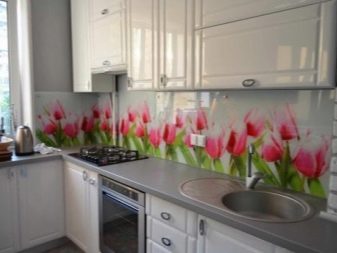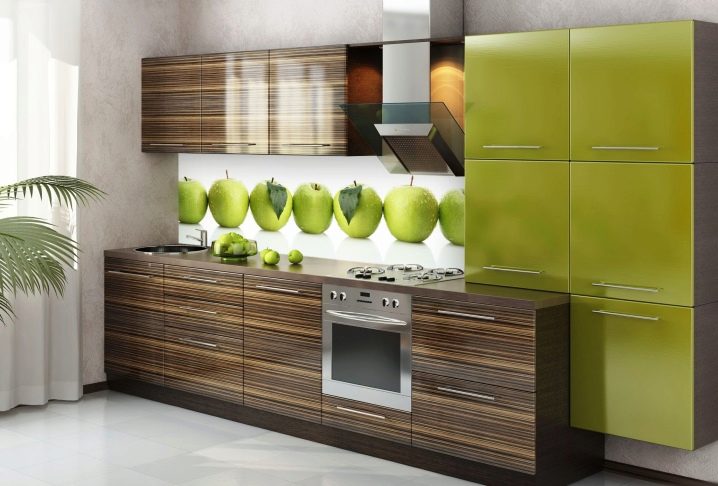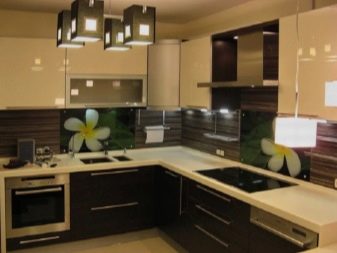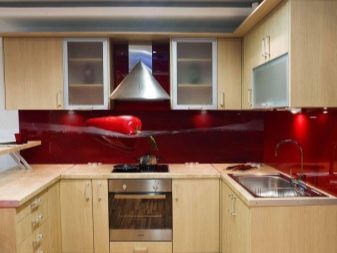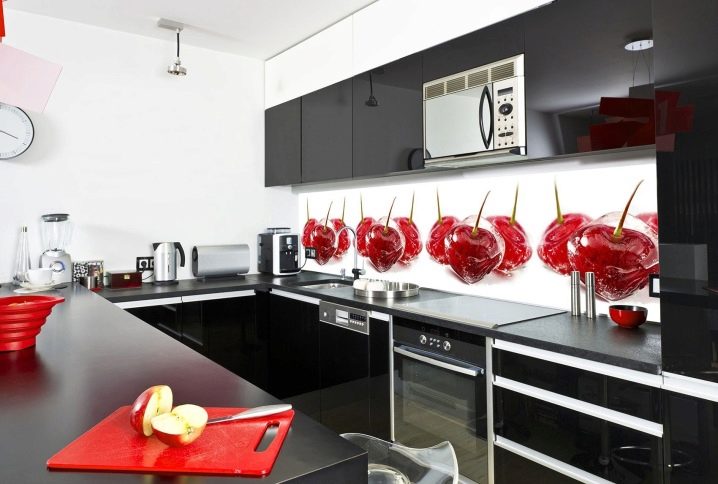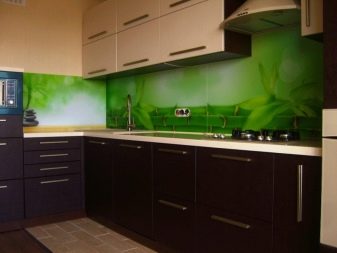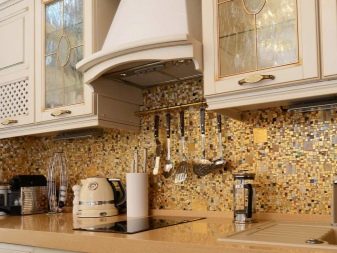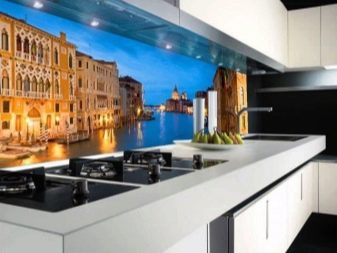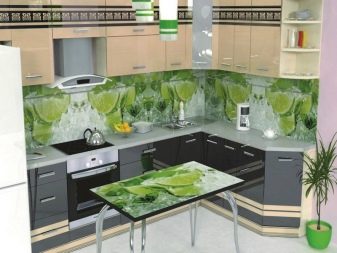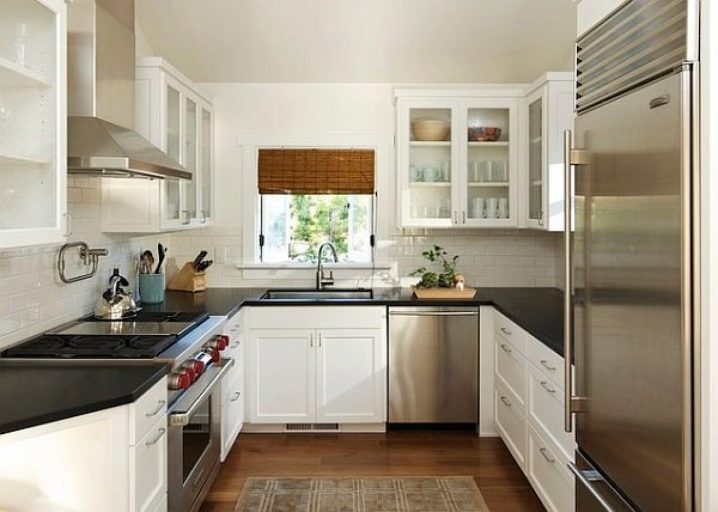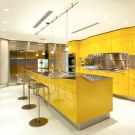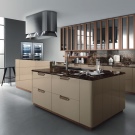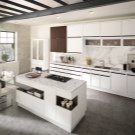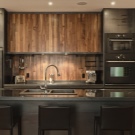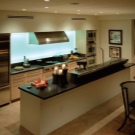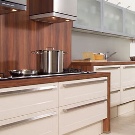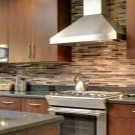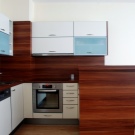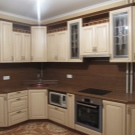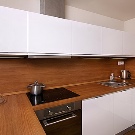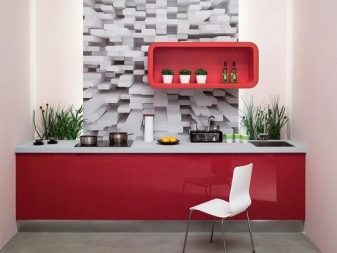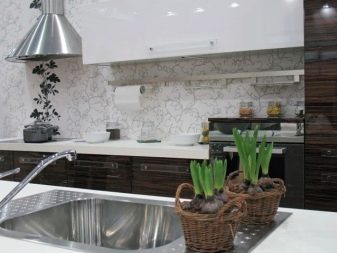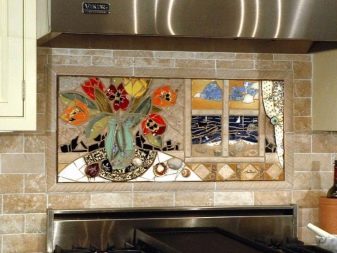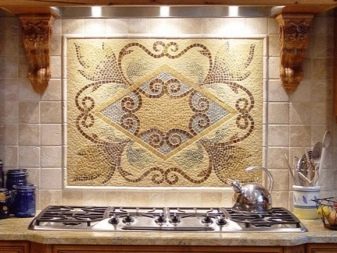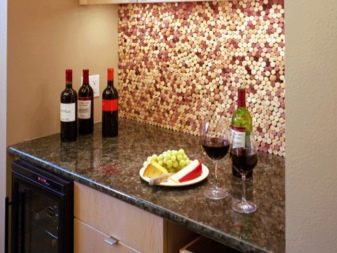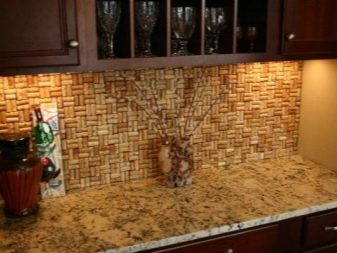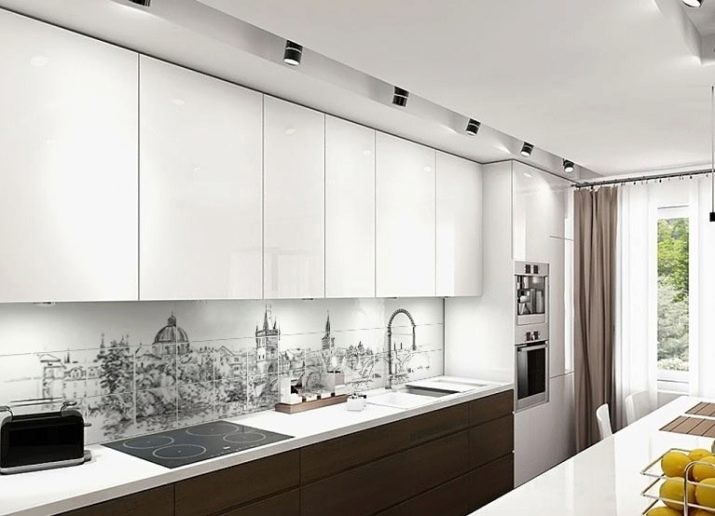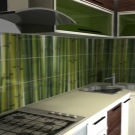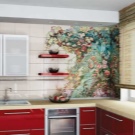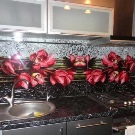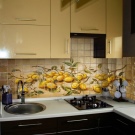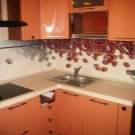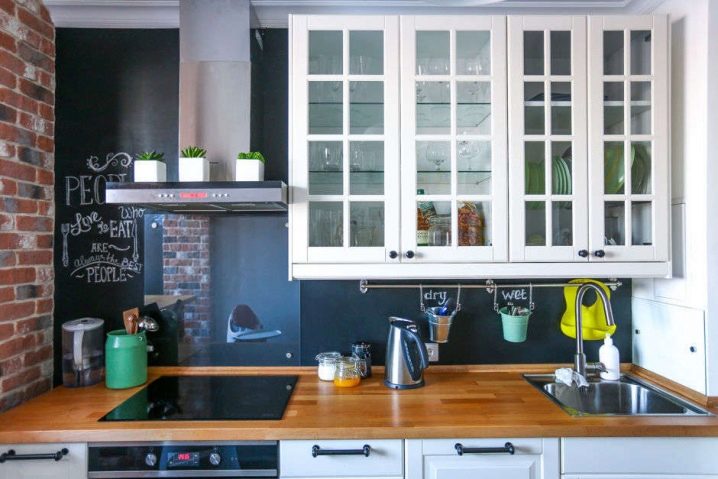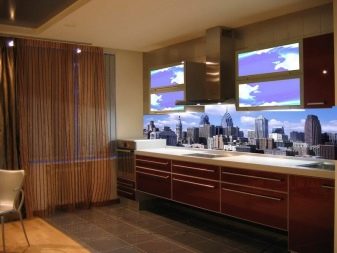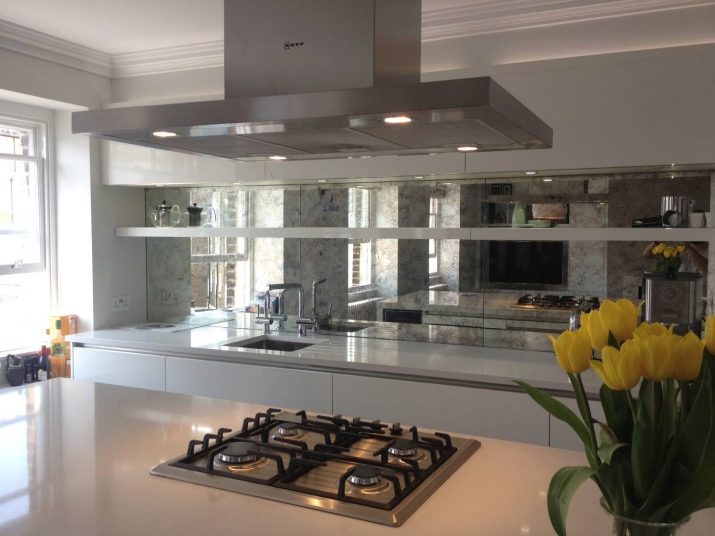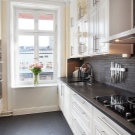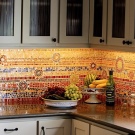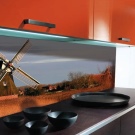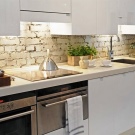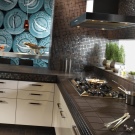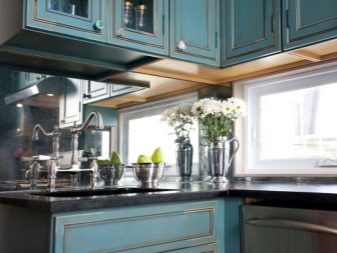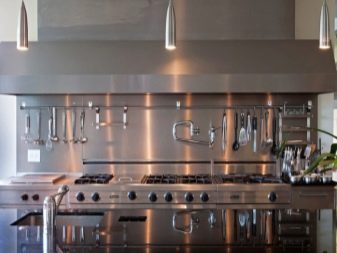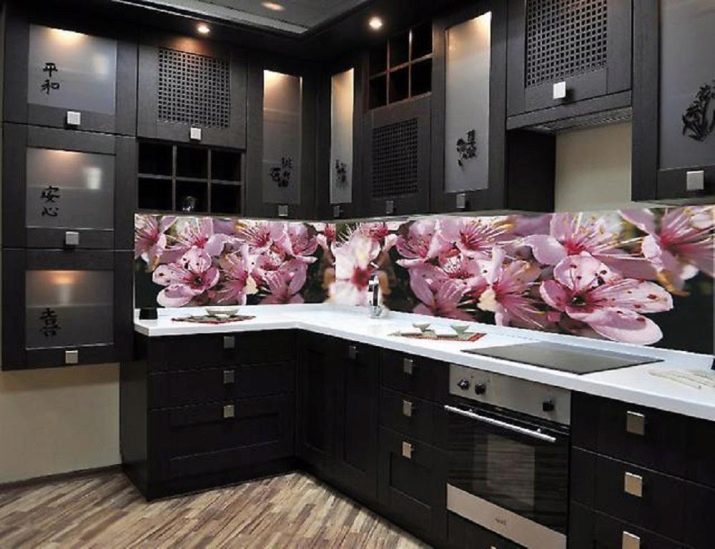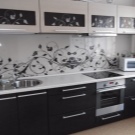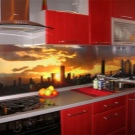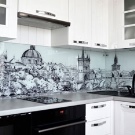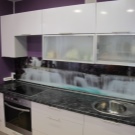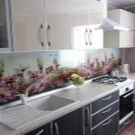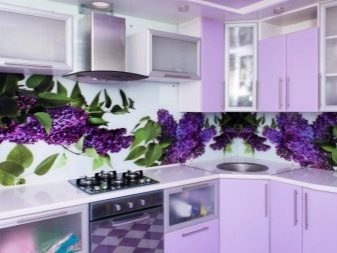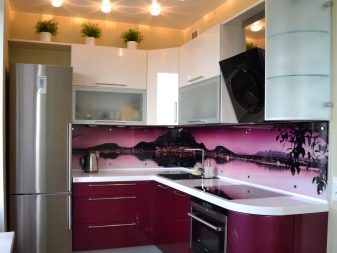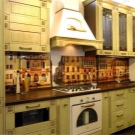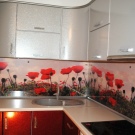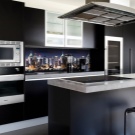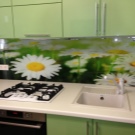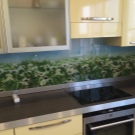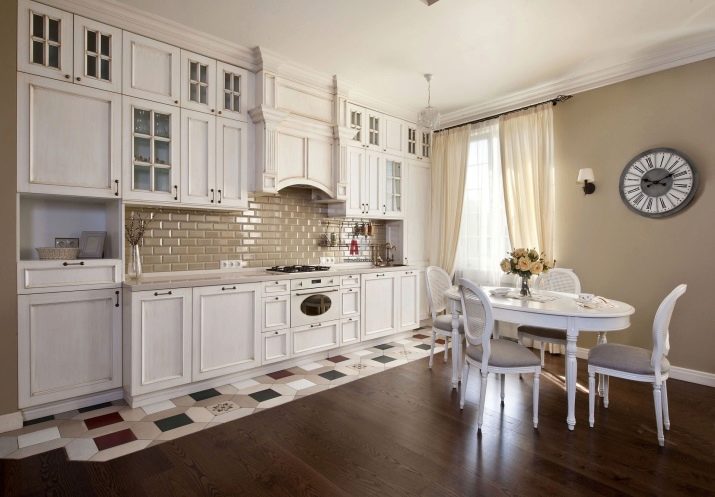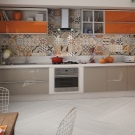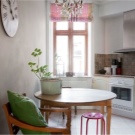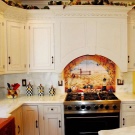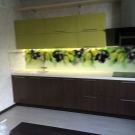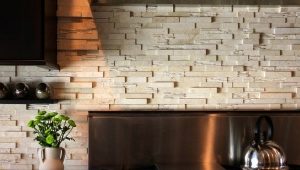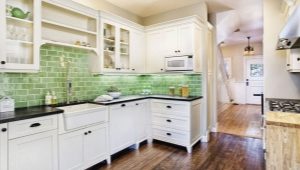Kitchen Apron
Kitchen apron is usually called the wall surface between the upper and lower cabinets, behind the sink or above the worktop. With the help of a kitchen apron it is possible to deliver a magnificent finishing touch to the design of the kitchen. Practically any material can be installed in this area, because it is not exposed to such a pressure of moisture as the walls in the bathroom, or strong pressure, like floor tiles.
Making your choice of material for the manufacture of a kitchen apron, it is worth considering both its appearance and wear resistance, and the method of installation.
Primary requirements
The main purpose of arranging a kitchen apron is to keep the wall of the working area of the kitchen clean. The choice of material is primarily influenced by practicality requirements. Since the kitchen is constantly used, it requires the design of the most moisture-resistant and easily cleaned materials.
Fat, colored spices and hard-to-remove juices of vegetables and fruits leave traces on the kitchen furniture and walls, so the choice of kitchen decor is far from a simple matter to decide,knowing the characteristics of each material used.
Materials
Materials for creating a kitchen apron varied. You can use the chic stone panels, and you can install and budget option: decorative fiberboard - panels. Such panels are made of wood fiber composition and covered with a laminating film that is resistant to water and scratches and provides durability. The advantage of this type of material is the moment that almost any skilled man will cope with its installation.
Polycarbonate is also called acrylic glass. It is used to finish the kitchen, as this material washes easily, does not allow mold fungi to multiply and is easily mounted. Polycarbonate skins are decorated with photo printing films, they can be used for about 5 years, until the drawing fades. In the future, such an apron can be easily replaced with a new one, without bothering itself with significant expenses.
You can make a kitchen apron out of polypropylene, such panels will protect the space between the cabinets and the table top. PVC panels, or sheet plastic is easy to clean, it is heat-resistant (but you should not allow direct contact with fire), it does not rot and is presented in a huge variety of colors.The minus of polycarbonate is that it is flammable. Such panels can be updated quite often, it will not be costly for the family budget. It is best to install them on a metal or wooden profile.
MDF - panels
MDF (or fine fraction) is a plate made of compressed wood dust. They can be sheet-like, like a large sheet of plywood; either tiled or slatted, resembling wooden lining. They are different from ordinary fiberboard coating. Usually this is a special protective film or veneer of expensive wood. There is also a carved surface treated with paintwork.
Thanks to this coating, MDF sheets are protected from moisture and mold, steam and moisture, so they can decorate kitchen walls, avoiding places of open contact with fire.
The advantages of this material include its environmental friendliness and simple installation. Mounted MDF or liquid nails, or screws with decorative plugs. However, the best is the option of mounting on aluminum profiles, which allows you to subsequently repair or replace elements of the kitchen apron from MDF.
Tile and tile
The tile is one of the most widespread types of material for the equipment of a kitchen apron.
Ceramic tiles and tiles are made of clay base, which is usually covered with a thin layer of glaze. This glaze is actually a variation of glass, which is melted and poured onto the base tile. The result is a durable material that can have a glossy, matte or textured surface. It is cut with the help of special equipment.
The ceramic tile apron is easy to clean; in the kitchen it is able to protect the wall from splashes of grease, moisture and overheating. In cases where there is a danger that the ceramic glaze may crack, you can use sealant to protect the tile.
Ceramic tiles are available in industrial and manual production as well as in a wide range of colors, sizes and styles. It is suitable for all kitchen designs, from modern style to "country", and can be easily combined with other materials, such as stone. Very attractive looks tile "pig", stylized as a brick wall.
In order to properly lay tiles, it is worth contacting a specialist, as the layout requires practical skill.
Mosaic
Mosaic is usually used in the arrangement of kitchens that have an attractive and unique look. Thanks to the use of various color schemes of the mosaic, it is possible with considerable ease to achieve a uniform and balanced design of the floor, cabinets, walls and all other kitchen utensils. Mosaic allows you to add creative decorative accents and even photos. Like tile, mosaic is made on the basis of clay, covered with glaze. It consists of small fragments measuring about 6x6 cm, resistant to temperature and humidity, and can last for many years.
The disadvantage is the mandatory surface preparation for installation, the need to find a professional installer, as well as the cost of additional materials.
Steel
Stainless steel is a durable material that endures temperature changes, is resistant to water damage and allows the use of any chemical detergents. Stainless steel metal kitchen apron looks unique and goodfits into hi - tech space. It is fire resistant, and its considerable cost is reasonable. Aluminum or steel, such a stylish finish would be appropriate for the kitchen "techno", "minimalism", or "hi - tech", in which the main advantage is utility.
However, the use of such material in any other design will be problematic, as it carries with it a very cold industrial fleur.
The disadvantage is the fact that the surface of the metal is very noticeable smudges, splashes and dirt.
Glass
There are many different types of glass tiles and glass skins on the market, all of them are suitable for creating a kitchen apron. Glass tiles are made from whole glass. In some cases, coloring pigments are mixed to create color, and in other colors are painted on the back of clear glass. Plexiglas is the simplest and most inexpensive, and triplex is the most luxurious.
The glass skin can be matte, textured or glossy and comes in several sizes. There are glass panels with photo printing and stereo printing, as well as glass panels with built-in backlight.Triplex can even mimic a fabric or leather surface. Therefore, the design of the kitchen apron glass can be embedded in almost any style decision.
Custom properties of glass are not inferior to the qualities of ceramic tiles. It does not tarnish and is not afraid of moisture. Glass panels do not have joints and seams, the options of tempered glass are not deformed by the heat of the gas stove.
Glass aprons are the most difficult to install, require the use of special cutting tools, especially if the design of the apron is designed with the presence of numerous holes, so it is better to invite experts to work.
A natural stone
The use of stone is ideal for any kitchen style. It can blend harmoniously into the traditional or rustic look of the kitchen; but you can combine stone with more modern materials, for example, with bright red modular cabinets.
Huge possibilities of choice provide natural natural shades of stone, such as granite, marble, basalt, travertine, slate or onyx. Usually tile made of natural stone is installed in a set with a table top. The exception is the use of tiles that mimic a brick wall. The “brick” wall is usually supplemented with a stone-tops tone.
Stone tiles can be in the form of sheets, mosaic (2, 3x2, 3 cm) or tiles (10x10cm). Naturally, the stone is a natural material, very resistant and durable. Its installation requires special knowledge and skills and is only for professionals. The most significant disadvantage of such material is its considerable cost and the fact that it is difficult to update such an apron.
Fake diamond
Artificial stone is a composite of mineral filler, pigments and acrylic resin. Its main advantage is a dense surface, durable in operation. It does not absorb moisture, prevents the growth of bacteria and fungi. Countertops made of artificial stone have a low thermal conductivity, and they are pleasant to the touch. Wall panels of this material look spectacular and expensive.
Artificial stone is durable, and in the case of scratches easily restores. It has no pores and is easy to clean with water with any dishwashing detergent.
Another advantage of adding artificial stone to the kitchen interior is a wide range of colors, a variety of ways to form a joint and the possibility of numerous design solutions.
The use of artificial stone allows you to create seamless surfaces of any size, giving a sophisticated look to the modern kitchen. The advantage of using this material can be called the fact that at the same time it is possible to make not only a kitchen apron and a worktop, but also a sink integrated into the overall elegant style.
The disadvantage is the need for professional installation and the high price of the material.
Natural wood
Regardless of what material the table top is made, arranging a kitchen apron made of natural wood will create a real homely atmosphere in the kitchen. In the style decision such material will approach the kitchen in the style of “country”, “Provence”, or in the classical style. The board can be both natural and veneered.
Different types of wood are used for installation, ranging from cheaper ones (alder, pine or linden) to solid wood (cedar, oak, beech). Oak is the palest material and is therefore easier to color for additional effect.
Mandatory pretreatment of wood with wax on all sides, thus the pores of the tree will be "sealed" and it will not absorb moisture and dirt. Another option is to use a water-based yacht varnish. From such a surface it will be easy to remove dirt and water leaks. In the zone of the plate wooden apron makes sense to combine with metal. Also during installation it is important to leave a gap between the wall and the apron, so that the tree “breathes”.
Installing a wooden apron is not too difficult; the owner himself can do this without the help of professionals. You can assemble the apron horizontally, vertically, or in the form of a mosaic.
Plastic
As an alternative to expensive materials, you can choose ABS plastic, which is also called an acrylic apron with photo printing. Such an apron is no less durable than a heat-resistant glass product; it is flexible and unbreakable and you can cut holes for the sockets without much difficulty.
The surface of acrylic panels is durable, resistant to scratches, steam and moisture.The drawings applied to the skinali can be chosen virtually for any kitchen design. Images are distinguished by excellent color reproduction and clarity.
Installation is carried out either on liquid nails, or with the help of battens.
Dimensions
To choose the size of the kitchen apron, you need to measure the height of the stove, floor cabinets and provide for the growth of the kitchen owner. There is a standard height of kitchen cabinets, which is 85 cm.
It should be noted that, most often, household appliances are installed under the worktop: washing machine or dishwasher. In this case, the cabinets are raised to achieve a uniform height (about 90 cm), or made to order. From this height it is worth making a start when calculating a kitchen apron.
First you need to check the floor level in the kitchen. The leveled floor is an important guarantee that the kitchen set will stand straight and look harmonious.
Usually the distance from the floor to the top of the tabletop is 90 cm. To clarify the bottom line of the apron, measure the height of the machine, add to this the thickness of the tabletop and a couple of centimeters so that the machine does not rest on the tabletop - this is the height from which the kitchen apron will be visible. In order to avoid the lower edge of the apron, it is lowered 2 cm below this border.
The top line of the apron should be hidden by 2-3 cm under the top cabinets. In the place where the hood is located, the border of the apron rises higher and it is arranged so that on each side there is a 15-20 cm protective zone around the hood. In the case of laying tiles this effect is easy to achieve, in other cases, you can use a combination of material. If the budget allows, in this area the apron can be laid out over the entire height of the wall up to the ceiling.
The size of the apron in the corner and direct kitchens in the apartment will vary. When the sink is located in a corner, this section of the wall should be protected as much as possible, so it is recommended not to hang cabinets over it, but to equip a kitchen apron the entire height of the wall. In the case when the cabinet is still above the sink (most often it is a drying cabinet), it is desirable to extend the kitchen apron 20 cm taller.
In small kitchens, for example, in “Khrushchev”, where the working surface is often increased by equipping the tabletop with a window sill, it is imperative to “stretch” the kitchen apron under and around the window sill. Thus, the kitchen space will be decorated more harmoniously.
For the kitchen island
A distinctive feature of such an exclusive version of the kitchen, as the kitchen - the island, is the work surface, placed in the center of the room in the form of a table. Sometimes the sink and stove are located on this “island” site. Usually it is combined with a dining area to make full use of the space. Such a design is possible only in fairly spacious kitchens, while several people can simultaneously be engaged in cooking.
In this case, the walls are necessarily equipped with wall cabinets, there is also a worktop surface under them, which is why a kitchen apron is also needed. In the case when kitchen zoning occurs when using multi-level surfaces, kitchen apron trim elements can beautify those few centimeters that create a height difference. Reviews of owners of such kitchens confirm that the material ideally suited for decorating an apron in an “island” kitchen is an artificial stone, from which it is desirable to also make worktops and sinks.
Economical options
If desired, to economically equip the kitchen space make a budget version of a kitchen apron.This option is to use MDF panels that are installed on profiles. This method of installation is convenient in that it is possible to replace a broken panel fragment. Moreover, the profile is mounted directly on the wallpaper, while saving time. Restoration of MDF - coatings are usually subsequently required only in areas bordering a cooking stove.
An even simpler option is to glue washable vinyl wallpaper into the gap between the cabinets. You can do this without even removing the old layer of wallpaper, if it holds tightly and does not exfoliate. In this case, the plinth and the corners will help protect the walls from leaking. You can make your own glass apron or its fragment. For this, a self-adhesive film or oilcloth is used instead of a film. It is fixed on the wall, forming a base, which can then be closed with acrylic or any other glass.
Unusual options
For those who want to design the kitchen not only in an original way, but also with their own hands, there are numerous interesting solutions. One of them is a panel on a kitchen apron made from cereals.The panel made in such a technique can be framed and used as an additional decor in a classic kitchen, a kitchen in the style of "country" or "Provence".
Other creative options are possible. For example, a kitchen apron from wine stoppers. In this case, the pattern is laid out in staggered order from traffic jams of the same size, cut in half. For the realization of such an idea, a special wax-plug for wall pasting is also suitable. Such an apron must be closed with glass to protect against water and dirt. This apron will be interesting to look complete with an artificial stone worktop.
For a kitchen apron made of tile, the decoration will be a self-adhesive version of the vinyl film. This choice will suit the owners of the kitchen of classical design, who do not intend to search for an interesting decor for a long time, because such stickers are in a huge variety, ranging from paintings with images of the street to stickers with jokes. The luminous effect of such stickers is due to their luminescent properties, while these samples hold for a long time and are easy to clean.
An interesting solution could be a slate apron in the kitchen,decorated in the form of a school board. On a similar wallboard, you can write with chalk, leaving reviews, tips and recipes. Made such an apron by painting the plaster with a special paint for slate boards. To enhance the effect, you can highlight the lower edge of the cabinets with a LED tape with yellow light. In this case, the wall paintings will illuminate the soft golden light, allowing you to read the smallest letters.
Designer Tips
In order to harmoniously arrange a kitchen apron, you first need to decide on the color palette of the kitchen. Before you start choosing a specific headset and finishing on the wall, you need to have in mind a big picture. It is important to determine the style and color direction. It is better to start from the floor and choose the material and color. Light or dark, wooden or laminated, gloss or matt. Do you want to see sleek and modern cabinets kitchen, or traditional or baroque? It is worth considering in detail all the examples, and only then make a choice.
Next comes the tabletop. Here again, the choice will not be easy, given all the available colors and patterns. And only then you can decide on an apron.
Thus, only a holistic picture, reflecting the style, colors and textures, will allow you to choose the option of an apron.
The main purpose of the kitchen apron is to protect the working wall of the kitchen. Therefore, it is necessary to take into account the daily need to clean the apron, and choose the one that is easy and convenient to wash. Also important is the moment how harmoniously fit into the design of the apron rod - railing.
For example, an unusual innovative version of the apron - with a mirror TV, will not be very convenient for cleaning.
Successfully selected details, such as stylish wall panels in the kitchen, or the alternation of simple ceramic tiles with tiled bas-relief, will contribute to the exclusivity of the design and delight the owners for a long time.
Successfully decorate the working wall can become popular in recent years aprons. In the event that the owners are not satisfied with the finished options, you can always order sketches and print on an individual project.
Popular styles and colors
Modern technologies allow to turn a kitchen apron into a real masterpiece of fine art in the interior of the kitchen.
Such an option as an apron - a panel of glass, or, as it is often called, skinal, allows you to decorate the wall with elegant high-resolution photo-painting. On skinali can find images for all occasions and for people of any warehouse. The LED cord installed on such an apron will allow to make an expressive accent.
Romantic girls will prefer kitchen screens with daisies, gerberas, poppies, tulips; Also on these skinali sakura or lilies will look great. Proponents of "techno" can find a stylish view of Manhattan, and for adherents of the classics, non-standard art abstractions or paintings in the style of "modern" are created.
Adherents of kitchen decoration tiles can choose glossy or matte surfaces for almost any color of furniture. For a spectacular red - black kitchen or for a tender salad kitchen, as well as for a chocolate kitchen, you can decorate an apron of tiles with bas-reliefs, rhombuses or mosaic patterns.
Supporters of the Provence direction will choose a kitchen apron in the style of “patchwork”, or a Scandinavian-style blue apron.
An apron with bright images, such as peppers or olives, will help create a positive atmosphere.A kitchen apron with a dark or pastel image will be calming.
Modern kitchen without color would look expressionless and lifeless. Nothing is able to decorate it better than a well-chosen apron!

